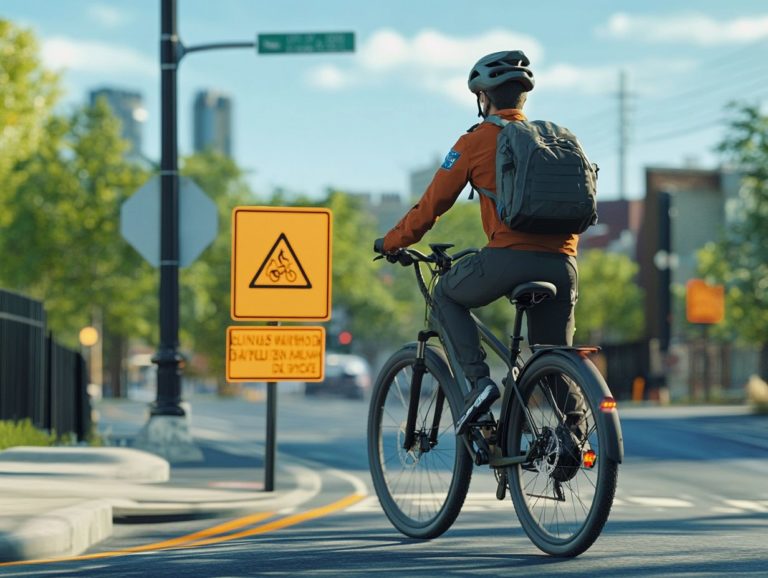Electric Bicycle Laws: A Comprehensive Checklist
Electric bicycles are transforming commutes and adventures. Yet, navigating the legal landscape can feel overwhelming.
Understanding the basics is essential for any rider. It s vital to stay informed about regulations on age, licensing, and safety.
This checklist will guide you through the complex electric bicycle laws. You ll ride safely and legally.
Whether you re a seasoned cyclist or new to this exciting world, you ll find valuable insights here.
Contents
- Key Takeaways:
- 1. Understanding the Basics of Electric Bicycles
- 2. Different Types of Electric Bicycles
- 3. Federal Laws for Electric Bicycles
- 4. State Laws for Electric Bicycles
- 5. Age Restrictions for Riding an Electric Bicycle
- 6. Licensing and Registration Requirements
- 7. Helmet Laws for Electric Bicycle Riders
- 8. Rules for Riding on Bike Lanes and Paths
- 9. Speed Restrictions for Electric Bicycles
- 10. Safety Requirements for Electric Bicycles
- 11. Insurance Coverage for Electric Bicycles
- 12. Riding Under the Influence of Alcohol or Drugs
- 13. Rules for Riding at Night
- 14. Restrictions on Carrying Passengers or Cargo
- 15. Consequences of Breaking Electric Bicycle Laws
- Frequently Asked Questions
- 1. What is an electric bicycle?
- 2. Do electric bicycles require a license or registration?
- 3. Can I ride my electric bicycle on the sidewalk?
- 4. Is there an age restriction for riding an electric bicycle?
- 5. Are there any speed restrictions for electric bicycles?
- 6. Are there any safety requirements for electric bicycles?
Key Takeaways:
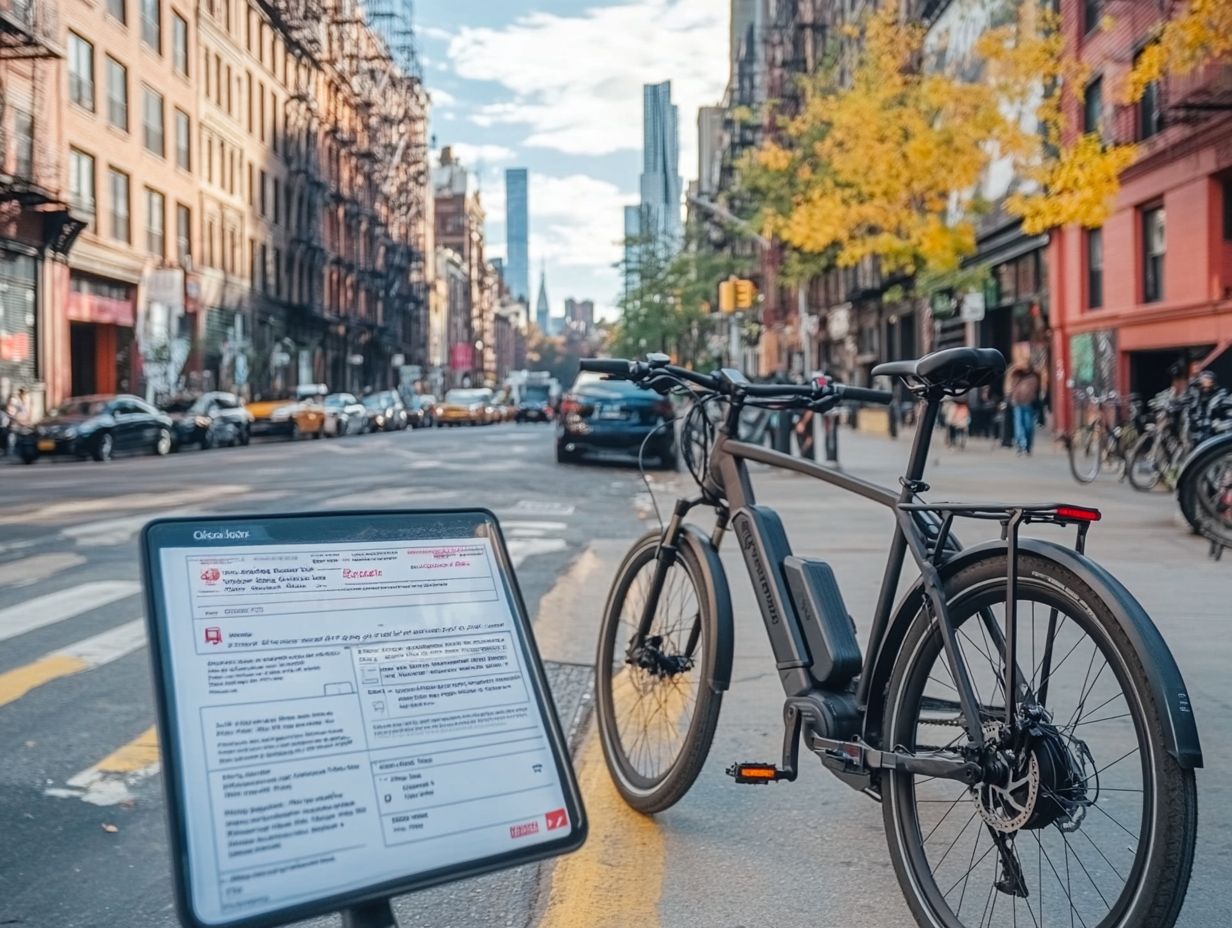
- Before purchasing, know the different types and federal laws for electric bicycles.
- Each state has its own regulations, so research them carefully.
- Be aware of age limits, licensing requirements, helmet laws, speed limits, and safety regulations to stay compliant.
1. Understanding the Basics of Electric Bicycles
Electric bicycles, or e-bikes, have gained popularity in the United States. They offer an eco-friendly alternative to traditional bikes and motorized transport.
To understand e-bikes, know their design and functionality. They combine the joy of cycling with the support of electric motors, making them appealing to many riders.
These bikes have a rechargeable battery that powers the motor. This offers various levels of assistance, making longer distances easier to tackle.
Eco-conscious riders appreciate the lower carbon footprint of e-bikes. This shift encourages more people to choose two-wheeled alternatives over cars.
E-bikes come in various styles, from city models for commuting to rugged versions for adventurous terrains. They promote safer riding while enhancing mobility in urban areas.
2. Different Types of Electric Bicycles
Electric bicycles fall into three classes: Class 1, Class 2, and Class 3. Each class caters to different riding preferences and regulations.
Class 1 e-bikes have pedal-assist systems that activate only when you pedal. They provide a natural biking experience and are limited to 20 miles per hour.
Class 2 e-bikes include a throttle for cruising without pedaling, perfect for leisurely rides.
Class 3 e-bikes, designed for experienced cyclists, support speeds up to 28 miles per hour. They are ideal for commuting and long-distance rides.
Understanding these classes is vital for choosing the right e-bike and complying with local regulations.
3. Federal Laws for Electric Bicycles
In the United States, federal laws for electric bicycles come from the Consumer Product Safety Commission (CPSC). This agency sets safety standards for e-bikes to ensure they are safe and reliable.
The CPSC mandates that e-bikes include features like effective braking systems and maximum speed limits. These measures are designed to protect you while riding.
Manufacturers are motivated to innovate within these regulations. This creates a culture of safety that benefits both them and you, the rider.
These guidelines help you feel more confident about riding e-bikes, ensuring you can enjoy this convenient mode of transportation securely.
4. State Laws for Electric Bicycles
State laws regarding electric bicycles can vary dramatically across the United States. California and New York showcase how local regulations shape your e-bike riding experience.
In California, the e-bike regulations categorize e-bikes into three different categories based on their maximum speed and assistance features. For Class 1 and Class 2 e-bikes, you don t need a specific license or registration, making these rides more accessible to everyone.
In contrast, New York has stricter rules, requiring all e-bikes, regardless of class, to comply with local traffic laws. In some areas, riding an e-bike may even be prohibited altogether.
As a rider in both states, you need to wear a helmet and follow age restrictions. These align somewhat with federal safety standards. However, the differences in state laws can greatly impact your riding experience.
5. Age Restrictions for Riding an Electric Bicycle
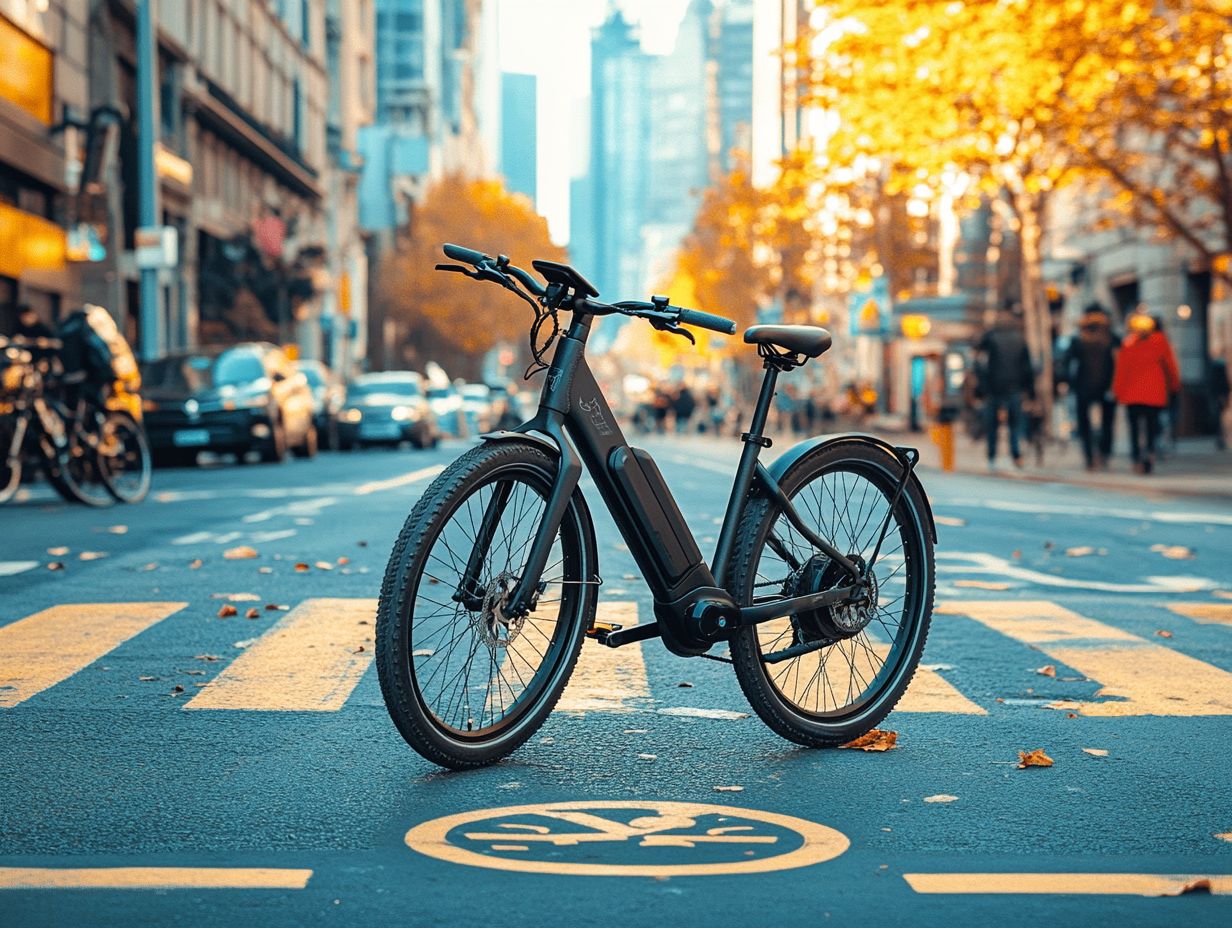
Age restrictions for riding electric bicycles are crucial, ensuring you meet specific criteria for safe operation.
These rules can vary widely from state to state and are designed to foster responsible riding habits while minimizing potential risks for both riders and pedestrians.
Some states require that you be at least 16 or 18 years old to legally operate an e-bike. This is based on the understanding that younger cyclists may not have the judgment and reflexes needed to safely navigate busy streets.
Focusing on age not only prioritizes your safety but also educates young individuals about responsible riding practices. By encouraging compliance with traffic laws and community standards, these regulations help ensure safety on busy roads now!
6. Licensing and Registration Requirements
Licensing and registration requirements for electric bicycles can vary significantly. This reflects the dynamic landscape of e-bike regulations and their integration into existing traffic laws.
In some states, certain classifications of e-bikes are exempt from registration, while others may require specific licenses similar to those for motorcycles.
The distinctions between Class 1, Class 2, and Class 3 e-bikes are crucial in determining the requirements you need to meet.
It s imperative for anyone considering the purchase or operation of an e-bike to familiarize themselves with the specific laws and classifications relevant to their area. This knowledge enhances your safety while riding and improves the overall experience.
7. Helmet Laws for Electric Bicycle Riders
Helmet laws for electric bicycle riders are essential for enhancing e-bike safety and reducing the risk of injuries during accidents. In many states, these regulations require you to wear helmets, safeguarding you against potential head trauma in case of a fall or collision.
By enforcing helmet use, authorities strive to encourage safe riding habits. Research consistently shows that when you wear a helmet, the chances of sustaining serious injuries drop significantly.
This proactive approach not only protects you as an individual rider but also fosters a broader culture of safety within the cycling community, reminding everyone of the importance of being vigilant and prepared on the road.
8. Rules for Riding on Bike Lanes and Paths
Understanding the rules for riding electric bicycles on bike lanes and paths is essential for your compliance with traffic laws and for enhancing your safety as a rider. This knowledge helps to create a harmonious environment for everyone sharing the space, including pedestrians and fellow cyclists.
Be mindful that speed limits often apply to e-bikes, ensuring that you don t pose a risk to others. Adhering to right-of-way principles is crucial; this means yielding to pedestrians and being considerate of other cyclists. Following these rules ensures not just your safety but also that of other riders and pedestrians.
By following these guidelines, you can enjoy your e-bike experience while fostering a safe and respectful atmosphere for everyone on the path.
9. Speed Restrictions for Electric Bicycles
Speed restrictions for electric bicycles are determined by their class designation, which influences how and where you can legally operate your e-bike. Each of the three main classes Class 1, Class 2, and Class 3 has specific speed limits.
Typically, Class 1 and Class 2 are capped at 20 mph, while Class 3 can reach speeds of up to 28 mph. These regulations not only affect your bike choice but also shape your riding habits and routes. For example, knowing that a Class 3 e-bike can only be used on bike paths or streets means you might lean toward urban routes, which can significantly influence your overall riding experience.
Sticking to these speed limits is crucial for fostering safer environments, reducing accidents, and ensuring that all riders can share the road responsibly, no matter which class of e-bike they have.
10. Safety Requirements for Electric Bicycles
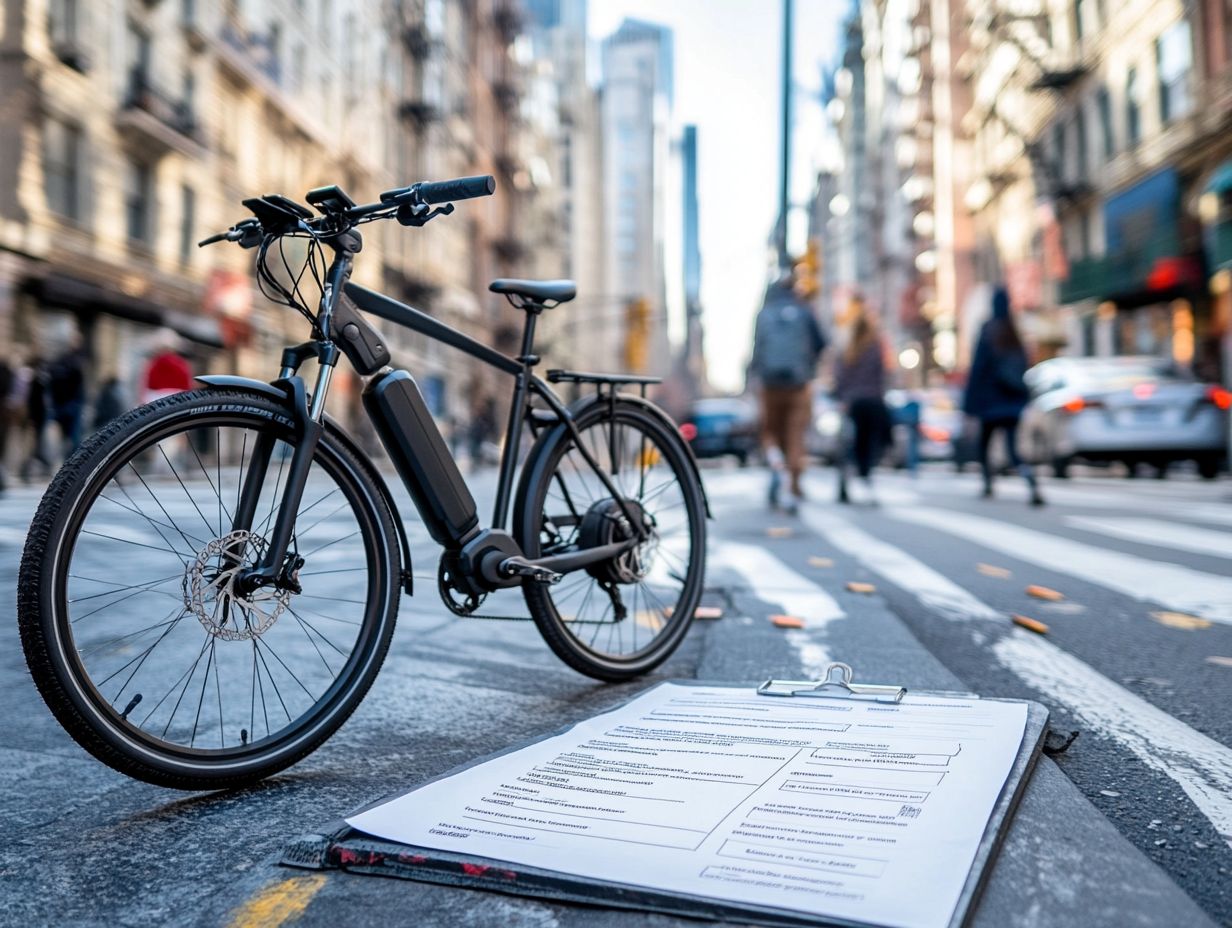
Safety requirements for electric bicycles are essential in ensuring that you enjoy a secure and compliant riding experience while adhering to CPSC regulations, which are safety standards set by the Consumer Product Safety Commission.
These requirements include various technical standards, such as brake performance, lighting visibility, and overall structural integrity. It’s crucial for you to follow specific rider guidelines, particularly regarding speed limits and the importance of wearing appropriate protective gear.
E-bike safety features, like integrated lights and reflectors, are vital in preventing accidents by enhancing visibility, especially in low-light conditions. You also need to stay informed about maintaining your electric bicycle to ensure optimal performance, which can further protect you from unexpected failures.
Ultimately, a thorough focus on safety standards not only enhances your individual security but also promotes a safer environment for all road users.
11. Insurance Coverage for Electric Bicycles
Insurance coverage for electric bicycles is becoming an essential consideration for you as a rider, offering financial protection against potential e-bike accidents.
With the growing popularity of these eco-friendly transportation options, it’s crucial for you to investigate the various types of insurance policies available. Options like liability coverage, which defends against damages to third parties, and comprehensive plans that cover theft and damage to your e-bike itself, are certainly worth your attention.
Factors such as your age, biking habits, and even the specific model and value of your e-bike will influence the details of these coverage options. Having insurance is a vital safeguard for you as an e-bike rider, helping to mitigate the risks associated with accidents or theft while underscoring the importance of responsible cycling practices.
Take charge of your safety explore insurance options today! Have you thought about the kind of coverage you might need for your e-bike?
12. Riding Under the Influence of Alcohol or Drugs
Riding electric bicycles while under the influence of alcohol or drugs presents significant risks that can lead to dangerous e-bike accidents and serious legal consequences.
These dangers are heightened by poor decision-making and diminished reflexes. These impairments can severely compromise your ability to navigate safely through traffic or avoid obstacles. Laws explicitly forbid operating any vehicle, including e-bikes, while intoxicated. The penalties for such actions can be severe, ranging from hefty fines and points on your driving record to potential license suspension.
Studies consistently show that substance use not only increases the likelihood of accidents but also intensifies the severity of injuries in the event of a collision. Thus, both the legal implications and the safety concerns associated with this behavior underscore the critical importance of practicing responsible riding habits.
13. Rules for Riding at Night
Riding electric bicycles at night demands your attention to specific rules that focus on your safety and being seen, especially in bustling urban settings. This vigilance is vital, not only for your own protection but also for the safety of pedestrians and fellow road users.
Outfitting your e-bike with bright front and rear lights enhances your visibility. This makes it easier for drivers and other cyclists to spot you in low-light conditions. Adding reflective gear, such as vests or armbands, further amplifies your presence on the road.
Following traffic signals is crucial for your safety and for others on the road. Respecting the rules of the road minimizes the risk of accidents during your nighttime adventures.
14. Restrictions on Carrying Passengers or Cargo
Restrictions on carrying passengers or cargo while riding electric bicycles are essential for ensuring safety and compliance with e-bike laws. These rules are key to keeping you balanced and safe!
Many jurisdictions impose specific weight limits, for instance, some places limit the total weight to 300 pounds, and prohibit transporting additional individuals to minimize the risk of instability. Adhering to these rules safeguards not only your safety but also that of everyone else on the road.
By following the established guidelines, e-bike enthusiasts like yourself can enjoy your rides with greater peace of mind, contributing to a more secure riding environment for all.
15. Consequences of Breaking Electric Bicycle Laws
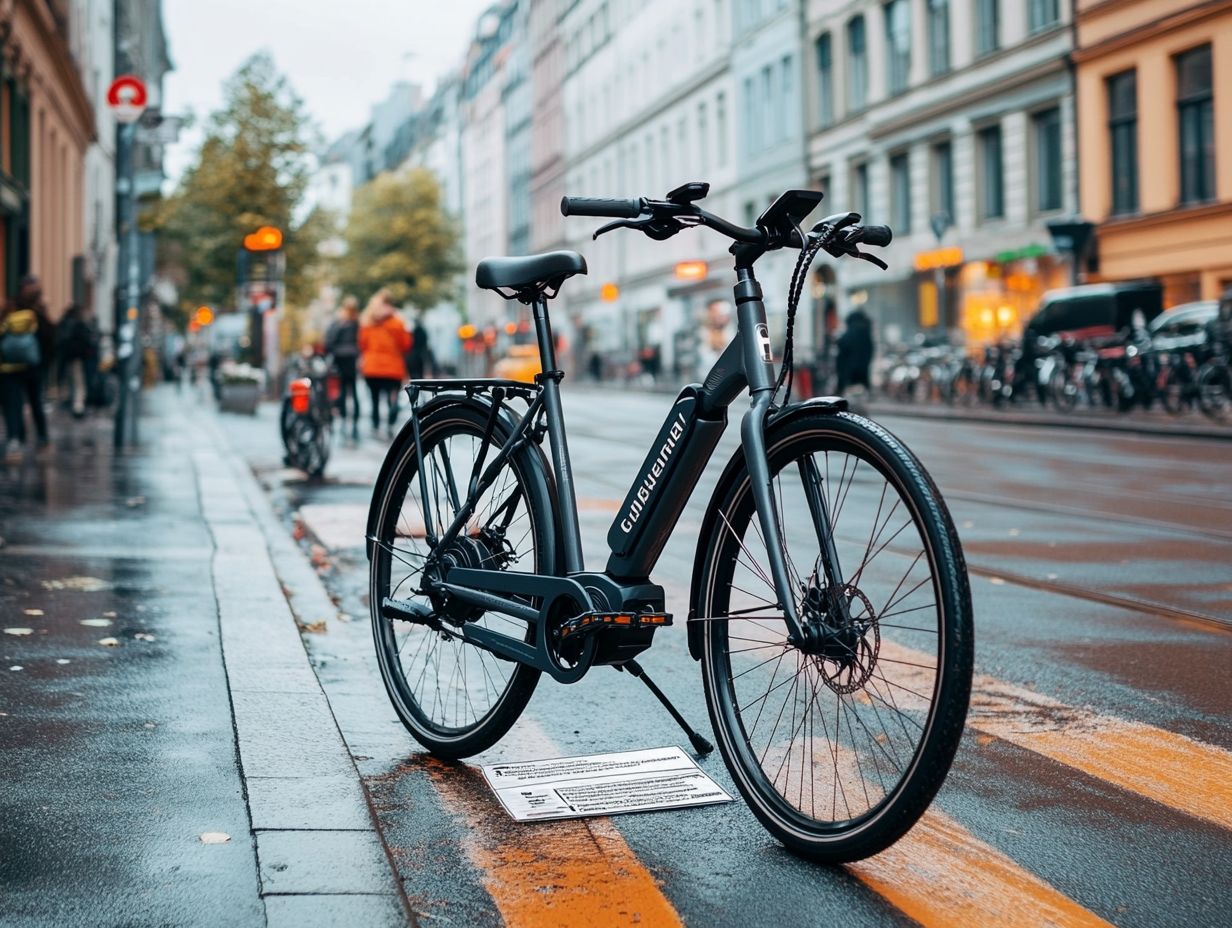
The consequences of violating electric bicycle laws can be quite severe, leading to legal troubles and heightened risks of e-bike accidents.
When you choose to overlook these regulations, you not only open yourself up to hefty fines but may also face restrictions that could affect your ability to ride your bicycle in the future. This creates a ripple effect; as more people disregard the rules, the reputation of the cycling community suffers. An increase in accidents can breed fear, making potential new riders think twice about embracing e-biking.
Ultimately, these penalties serve as a crucial reminder that adhering to the laws is essential not just for your own safety, but for cultivating a responsible culture shared among all cyclists.
Frequently Asked Questions
1. What is an electric bicycle?
An electric bicycle, also known as an e-bike, is a bicycle equipped with a small electric motor and battery that assists with pedaling and can reach speeds of up to 20 mph.
2. Do electric bicycles require a license or registration?
In most states, electric bicycles do not require a license or registration as they are classified as bicycles with motor assistance. Make sure to check your state’s laws for details.
3. Can I ride my electric bicycle on the sidewalk?
In most states, electric bicycles are not allowed on sidewalks as they are considered motorized vehicles. It is important to ride on designated bike lanes or on the road following the same rules as traditional bicycles.
4. Is there an age restriction for riding an electric bicycle?
The minimum age to ride an electric bicycle is usually 16 years old. However, check your state s laws, as some may have different age limits.
5. Are there any speed restrictions for electric bicycles?
The common speed limit for electric bicycles is 20 mph. Some states may have different limits based on the type of e-bike, so make sure to verify your local regulations.
6. Are there any safety requirements for electric bicycles?
No license or registration is needed for electric bicycles. Always wear a helmet and follow traffic laws to stay safe.
It s wise to add lights and reflectors to your e-bike for better visibility. Stay safe and ride smart!






